On the 25th anniversary of the death of the great American pianist Joseph Villa, I am creating this page dedicated to him and his artistry. The passing of this great pianist on April 13, 1995 at the age of 46 as a result of AIDS-related complications was a tragic loss to the musical world. A level of recognition worthy of Villa’s prodigious musical abilities had eluded him, and he was mostly admired by some of the cognoscenti of the piano and a handful of famous musicians such as Alicia de Larrocha (who attempted to help him get more bookings) and Jessye Norman (who had Villa play at the opening of the concert venue in her home and on other occasions – one of which he left the hospital in order to play). My own introduction to Villa – both as a pianist and as a person – had a huge impact on me at a formative time in my exploration of great piano playing.
In 1991, I received a cassette from Gregor Benko, founding co-president of the International Piano Archives. On the one side was a recording I had been expecting with great anticipation: the great Josef Hofmann performing the Beethoven ‘Emperor’ Concerto with the Chicago Symphony Orchestra in the 1930s, at that time only issued on an expensive multi-disc set produced by the orchestra and never otherwise made available. The other side of the cassette had a live recording made in 1991 of Rachmaninoff’s Second Sonata played by a pianist unknown to me called Joseph Villa. I had never connected with that work and had never heard of the pianist, and while I had hoped for something historic in nature, I thought it must obviously be interesting playing if Gregor had seen fit to include it on this cassette. I had no idea what I was getting into.
I listened to the tape and didn’t quite know what to make of the music (it wasn’t one of my favourite works at that early stage in my exploration of piano recordings) but it became clear as I listened that this was some stupendous playing. I found myself unable to multi-task as I listened, as the playing was so magnetic, intense, and intoxicating – I could barely grasp what was happening, but I knew that it was something extraordinary. The faded, muddled recording had been made at a concert held on a barge off the Brooklyn Bridge by someone who had had the foresight to set up a microphone with a Walkman and captured a performance that might have disappeared into the ethers. Instead it opened up the world of a pianist who might have continued to be even more unknown to the musical world than he already was.
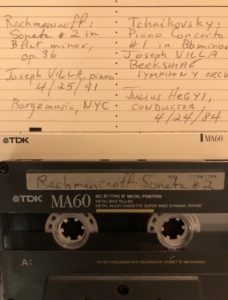
I listened dozens of times to the tape, poring over nuances that seemed impossible to achieve by hand. I was reminded of Dinu Lipatti’s incredible glissandi in Alborada del Gracioso; there were technical feats in this live Villa performance that made the hair on my neck stand on end. He could hold a melodic note as a flurry of other notes cascaded downwards, and a few moments later tie that note over to the last note in that flurry without breaking the line of the melody or the filigree passagework (5:52 to 5:56). Like Lipatti, Villa was capable of phrasing a note so that it fit into both the accompaniment and the main melodic line, so that you could hear its simultaneous function (4:09 to 4:12, among others). He could highlight the palpable difference in vibration between different chords, and handled harmonic shifts with uncanny timing and nuancing (3:49 to 4:05). His accenting was phenomenal, with an ability to provide a subito that did not break the line (7:24). He not only had a comprehensive architectural overview of the work, but had technique to achieve what seemed impossible and yet which might easily go unrecognized by the listener (the descending 6-note motif is consistently voiced throughout the work). And then there is that volcanic sound, discernible even through the less-than-perfect of the amateur recording.
Fortunately this performance the Rachmaninoff Second Sonata has been on YouTube for a decade, whereas during Villa’s lifetime actual cassettes needed to be mailed from person to person to be able to access this amazing performance, and as a result his name and this incredible performance are now better known by a wider range of piano lovers than was the case during his lifetime. I have now uploaded a transfer of the cassette that Joseph himself made me so that the sound quality is rather improved. This is certainly a reading that is not for the faint of heart: it is an intense piece of music and the performance is of incredibly raw emotional expressiveness and probing musical depth, and the sound is not ideal, but it is eminently worth examining if you are a fan of the piano. Of the thousands of hours of piano recordings that I possess, this is one of the few that amazes me time and time again – supreme playing of a musician of the highest order, in my opinion one of the greatest piano recordings ever made.
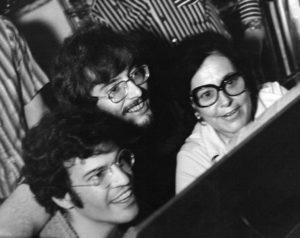
After listening to the cassette a few times, I excitedly called up Gregor, who raved about Joseph’s playing, stating that he was one of the greatest Liszt pianists ever and was languishing without a career, despite the adoration of luminaries like Alicia de Larrocha and Jessye Norman. I couldn’t understand how such an incredible musician, a real throwback to the ‘golden age’ of pianism, could be unknown – it simply didn’t compute.
Within a year – May 1992, to be precise – I made a visit to New York and Gregor arranged for me to meet Joseph. I went to his apartment on 54th, around the corner from where David Letterman’s late night show was filmed, and was greeted by Joseph with a very warm but calm demeanour, and welcomed into a small living room in which a piano was in prime position in front of the seating. The details about the specifics of the conversation are hazy – this is almost 30 years ago and I was quite nervous and starstruck at the time – but I recall that we talked a lot about interpretation and performance, and about his performance of the Rachmaninoff Second Sonata. He had learned the work for a concert for Bargemusic, an organization that presented small concerts – a stupid move, he said, since the work was fiendishly difficult and he was only going to play it three times. He had also researched the various editions of the work and sought to find the best approach to the work, eventually arriving at the same conclusions as Horowitz, and hoped that people wouldn’t think he just copied Horowitz because he hadn’t.
We talked about many pianists and saw eye-to-eye (and heard ear-to-ear) on all the greats. We had a moment listening to Lipatti where I became aware of his ear for detail and our aligned points of view: there is one spot in the live recording of Chopin’s First Concerto where Lipatti accents the offbeat in a bar featuring a massive run of notes – an unusual nuance I’ve never heard anyone else do – and as we were listening to this passage, and immediately after that accent, Villa turned to me and said “Ooooh, niiiice…”. No one I had played this recording for had ever shown that they recognized that particular effect that Lipatti achieved. Villa’s playing was full of that attention to detail, but was more wildly passionate than Lipatti’s more controlled approach: he had a combination of Lipatti’s architectural overview, Hofmann’s explosiveness, Friedman’s singing line – and the comparisons could go on, but essentially he was unique interpreter with the individuality and manifold pianistic qualities that one heard amongst the legendary pianists of the past.
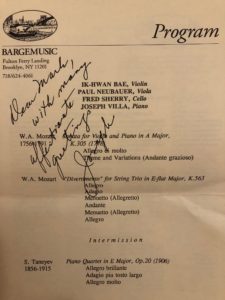
Fortunately I had the opportunity to hear Joseph at the Bargemusic concert being held during my visit to the city, although he played no solo music at that performance, only chamber music. His playing was of course wonderful but the repertoire did not provide the full opportunity for his titanic pianism to shine. To think that this had been the same Barge where that incredible concert had taken place – how I wished I could have traveled back in time!
We got together another couple of times that visit: once to visit the Frick Collection together with his partner Steven – an occasion when I got to witness more of Villa’s attention to detail as he spoke so eloquently about the artwork we observed – and again just prior to my departure (by car) back to Montreal when he came to say goodbye. (I know we took a group photo at the time but I haven’t been able to find it.) Every year until he died, he sent me a Christmas card and the occasional note while I was living in Tokyo, and Benko had him sign Bargemusic concert programs for me when he attended. I had another opportunity to visit him in New York – I believe it was the Spring of 1994 – together with a Finnish collector friend who was visiting the city at the same time; once again, generosity in spirit and elegance in demeanour. Alas, also once again he resisted our gentle suggestions that perhaps he would consider preparing the Liszt Sonata, which surely would have been an interpretation for the ages; being rather young and not knowing him well enough, we did not feel that this was a point that we would press (we knew others had raised it with him and simply hoped that if a few more made the suggestion, he might consider it) … the fact that he never played or recorded this work is a significant loss to posterity.
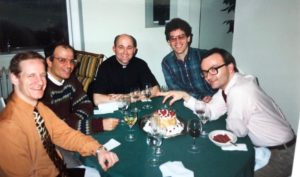
Joseph died of AIDS-related complications not long after that last visit I made to New York, on April 13th, 1995, at the age of 46 (his New York Times Obituary is still online). Stephen Hough has continued to speak of Joseph in glowing terms – the two artists can be seen at a dinner in the photo on the left.
Given the dearth of the artist’s musical output, I am creating this page of YouTube uploads of concert and studio recordings – both audio and film – as well as audio programs devoted to the pianist as a reference point for those who wish to appreciate the artistry of this incredible musician.
First off, here is dedicated feature podcast-style episode that I produced in honour of Joseph, telling in more detail some of what is above, interspersed with some recordings:
And an episode of The Music Treasury on KZSU Stanford in which host Gary Lemco and I presented Villa recordings and discussed his playing. While I’d previously made a number of appearances on Lemco’s program by telephone, on this occasion I was in the studio in person and can attest to the host’s visceral response to Villa’s pianism: he had never heard the pianist play before and on several occasions while the music was airing, he would shiver and occasionally almost jump out of his seat in amazement at the sheer power and musical depth of Villa’s artistry.
While the Thursday night performance of the Rachmaninoff Sonata No.2 from Bargemusic – on April 25, 1991 – has reached legendary status, it was as I stated one of three performances. The Sunday afternoon concert performance of April 28, 1991 was captured by Ray Edwards, then manager of the classical department of Tower Records in New York. He had heard talk of Villa’s glorious traversal of the work a few days earlier and set up some better equipment to capture the Sunday afternoon performance. I recall listening to a few moments of this reading with Joseph himself when I visited him in 1992 – when we heard more audience noise, he commented, ‘It was the Bloody Mary Sunday crowd’ – and while he admitted that it was not as volcanic or ‘together’ an interpretation as the Thursday night reading (which was his first public performance of the work), there is certainly some outstanding pianism to be heard. This performance overall features a broader, more expansively phrased lyricism than the one from a few days previously while still featuring stunning feats of virtuosity, magnificently coordinated voicing, and incredibly impassioned pianism.
Villa had a particular affinity for the music of Scriabin, recording two CDs of the composer’s music that were issued on the Dante label in France (the first was recorded for the American label Second Hearing, but as the label went under before it could be issued, Dante took over the project). The recordings (at least for some of the performances – including the one below) were made in a small church in upstate New York at night. When he was playing this mystical ‘White Mass’ Sonata, there was reported a certain “charged” feel to the atmosphere in the church that evening, and toward the end of the recording of the Sonata, lights flickered quite mysteriously, spooking the technicians but in a strange way reassuring Joseph of a job well done.
Here are the complete 2 discs that Villa produced of Scriabin’s music – truly reference recordings!
Joseph sent me two cassettes of concert recordings, all of which I have uploaded to YouTube. One of the performances that I remember him being very happy with was a July 1990 performance of the Tchaikovsky Piano Trio in A Minor, together with William Preucil on violin and John Sharp on cello. In this excellent fidelity radio recording, we can hear all musicians’ tone with great clarity, as well as the remarkable synergy between the three musicians, and this reading showcases Villa’s rich, full-bodied tone, impassioned musicianship, and lyrical phrasing.
Concerto performances of Villa were rare – he was simply not well enough known to be regularly booked for such events – though he did give a few and there are some stupendous recordings, albeit not in great sound. Two captured on tape were given to me by the pianist himself, one of them a titanic performance of Rachmaninoff’s Piano Concerto No.1. Although this too is an amateur recording made from the audience, it captures the excitement and musicality of Villa’s thrilling playing, with stunning runs, massive dynamic range, and impassioned phrasing. Villa was delighted with this particular reading and I am delighted to have been able to share it to YouTube:
The other concerto recording that Villa gave me on cassette is an April 24, 1984 concert performance of Tchaikovsky’s Piano Concerto No.1 Op.23 with the Berkshire Symphony Orchestra conducted by Julius Hegyi. Again, the sound is not that of a professional recording – it was made from the audience – but the pianism is phenomenal, with Villa’s massive dynamic range, lushly Romantic phrasing, attentive voicing, rhythmic propulsion, daring tempi, and staggering technical proficiency all in full abundance.
And now we have at last the opportunity to see Villa in filmed performance, with the first ever availability of some terrific performances. First is a 1984 concert of Joseph Villa playing Chopin’s F Minor Concerto Op.21 with the Youngstown Symphony Orchestra, with Peter Leonard conducting. Villa was booked the night before the performance to fill in for a major pianist (one friend of the artist believes it was Claudio Arrau) and he gives an absolutely stupendous performance, demonstrating the musical gifts that were hallmarks of his pianism: a rich tonal palette, refined nuancing, and remarkable dexterity, his technical proficiency fully at the service of the music.
Next are two filmed performances of Villa playing Liszt, from a June 21, 1990 concert at the La Festival de la Grange de Meslay in Tours, France, on June 21, 1990, which was also La Fête de la Musique in Europe, the first day of summer. In these two superb readings (more was played, I’m not sure how much more was filmed) before an audience of about a thousand, we hear Villa’s marvellous combination of refined nuancing and heroic intensity, with a wide dynamic range, impressive array of tonal colours, natural timing, and declamatory phrasing. Apparently, during the performance, the lower portion of his thumb near the palm on the left-hand went numb; Villa continued his performance and described it as playing the last quarter on “auto-pilot” with a hand nearly paralyzed, yet there were no signs to anyone in attendance that anything was amiss. First here is a performance of the Invocation, S.172c:
Then is a glorious and heroic traversal of a work that he played regularly, Harmonies du soir – a work that he played in concert for the bulk of his career and t0 which he brought his very personal combination of depth and passion:
To close, one of the performances that captures the truly orchestral nature of Joseph’s playing to perfection: a 1989 concert recording of Liszt’s arrangement of Beethoven’s Symphony No.5 – it is included in the radio programs above but it is worth having it easily accessible here, as the interpretation is absolutely stunning. The piece is fiendishly difficult, as this video and interview (in French) of Villa rehearsing it reveals (many thanks to our friends at Meloclassic for sharing this on their Facebook page), and yet his playing is of the utmost clarity and precision:
This truly symphonic playing is absolutely jaw-dropping: we hear such clear voicing, with varying timbres for different melodic lines, with consistent beauty of sound – and to think that this is a complete unedited concert performance!
There are more performances of Villa on YouTube that are well worth exploring, and other unpublished recordings have not yet been made public – and more might be added to this page at a later date. Fortunately, unlike the time when I first encountered his playing and met him, technology now allows for the wider public to be able to easily access this artist’s performances and experience directly the incredible power of his music-making. Long may his artistry be appreciated and remembered, and serve as inspiration.
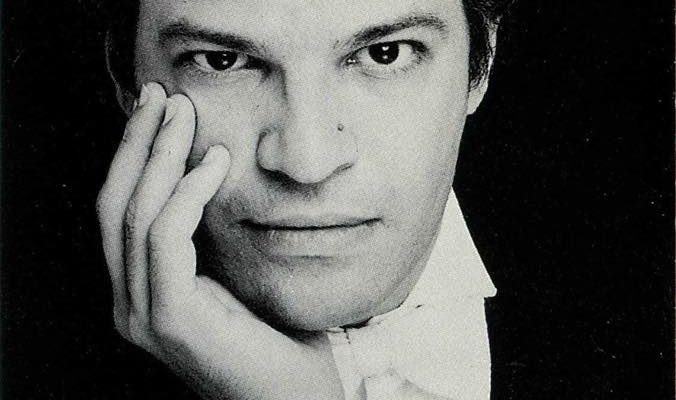
Comments: 5
Thank you for this – especially the films! His hands often show the flat-finger “Russian” approach taught by his most important teacher, Sascha Gorodnitzki. Joseph Villa’s playing deserves to be heard *between* anniversary days.
Thank you for your tribute to Joseph on your program today, James – I’m glad we’re all on Team Villa and ensuring that this incredible musician is not forgotten!
Fantastic page dedicated to Joseph Villa!!! Thank you so much!!
A pleasure – so glad you remember him too!
Wow, thanks for a masterful collection of virtuoso Joseph….I will listen to every one of these…..multiple times.